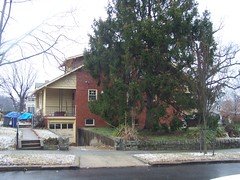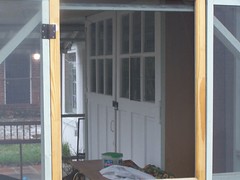Parking in historic districts
(This is a reprint of something I wrote on the Preservation Forum e-list, although it has been edited).
Regarding this query, there are two other and I think more important ways to consider this issue.
1. is in terms of the history of urban design in relation to historic neighborhoods and how neighborhoods and housing production practices changed in order to accommodate the car in response to its invention; and
2. is focused on making sure that transportation and neighborhood planning goals are congruent and that parking and curbside management policies are properly and adequately reconciled with neighborhood preservation policies.
1. Urban design.
When considering historic preservation in DC and the city's competitive advantages, at first I bound together in one concept two very different aspects: historic architecture and the urban design/urban form of these neighborhoods (small blocks, zero lot lines, sidewalks, no curb cuts on the face blocks of streets except for alleys, houses served from rear alleys, carriage houses/outbuildings, etc.). After awhile, I realized that I had to separate out the characteristics of the building architecture from the urban form aspects, in order to properly interpret the characteristics and value of the place apart from the buildings.
Urban form during the period of the walking city (1800-1890) and the streetcar or transit city (1890-1920) was very different from the automobile-centric zoning codes that typify regulations across the country.
(From a transportation sense, these concepts were laid out in a classic paper by Peter Muller. "Transportation and Urban Form: Stages in the Spatial Evolution of the American Metropolis," appears in the 2nd and 3rd editions of the textbook Geography of Urban Transportaton. A kind of summary is here.)
You can see this progression in how DC neighborhoods and houses were designed in periods before or after the introduction of the automobile. For many years, I lived in Greater Capitol Hill, and most of the buildings were constructed (1860s-1920) before the existence and/or widespread use of cars. Alley buildings were originally constructed to stable horses, and eventually were converted into garages.
Now I live in the upper northwest quadrant of the city, in a neighborhood that was constructed for the most part in the 1920s and 1930s and rather than incorporating the car as an afterthought, into buildings originally constructed for horses, building plans accommodated vehicles from the beginning. However, housing cars was made subsidiary to housing people.
Cars were accommodated either by separate garages on the lot, accessed for the most part through rear alleys or for corner lots, through garages accessed from the street, in garages integrated into the house but in a less prominent fashion, i.e., basement side entry garages located on the house perpindicular from the front facade, with steep slopes and curb cuts, or entire blocks of rowhouses with rear entry basement garages.

Brick bungalow at the end of my block. The house faces 2nd Street, but the garage is entered from Quackenbos Street. When we were house shopping, we looked at a rowhouse on 311 Gallatin Street NW--still on the market, with a reduction in price--where I also learned about rear entry garages in rowhouse blocks. The original doors and garage are still extant in that house. I would have gone over and photographed it for this entry, but with the snow and my attitude of the moment, I am not up to it.

The front of the bungalow.
(Although it appears as if some detached houses may have had rear entry garages within the basement of the house. In the case of my next door neighbor, where original carriage house garage doors are still intact on the back of the house--but no garage is located in the interior--the distance from the back of the house to the end of the rear lot line is 80-90 feet.)

The garage doors on the back of my next door neighbor's house.
What is interesting is how the prominence of the garage or "house" for the car has become far more pronounced as private automobility, rather than transit, became the predominate U.S. practice.
In the 1970s, growing up in a suburban subdivision in the Detroit area, almost all of the houses had garages that were prominently positioned as a key feature of the front facade. (In my current neighborhood, similarly some houses, perhaps dating from the 1940s, have very small front yard entry garages, for one car, accessed via a curb cut from the street.)
Today, with snout houses, garages are an even more prominent feature of typical American housing.
So, from a "how to use the history of urban design and architecture to support exceptions from current zoning regulations" standpoint, it is important to ensure that our local historic preservation laws include protection of historic urban design as well. This provides the historical justification for limiting the accommodation and centrality of the automobile in planning regulations, because the automobile was not present or significant in these neighborhoods during their original period of architectural significance.
Even though the urban design of neighborhoods is not the complete reasoning for why historic districts in DC have an exception from the parking regulations in the zoning code (which was passed in 1958, many many decades after the construction of what are now historically designated neighborhoods), balancing regulations in favor of exceptions to traditional car-centric regulations comes out of this broad line of reasoning. As does the fact that typically, the neighborhoods designated as historic were constructed of houses without garages integrated into the house, especially in the front of the house, and therefore it is virtually impossible to get approvals for curb cuts in historic neighobrhoods in DC.
(It happens that in DC, the L'Enfant Plan, the urban design for the original "Old City,"is a historic landmark on the NRHP, however I don't think this is why DC historic districts enjoy an exception from standard parking regulations.)
2. Reconciling parking and curbside management and neighborhood planning policies.
Few cities have detailed and thorough transportation plans on the scale of the plan for Arlington (County), Virginia--an urban county outside of DC that functions for the most part as a city. As a planner, and as a reader of a wide variety of commercial district, tourism, transportation and other plans, I find that this plan is one of the best in the country in terms of how it sets out primary goals and the resulting objectives, and how each element of the plan is internally consistent, that the polices and regulations laid out within each element derive directly from and are consistent with the goals in the initial outline chapter of the plan.
Arlington has made mode shift away from private automobile trips generally, and from single occupancy vehicle trips specifically, a key goal and priority of the plan. What this means in the element on parking and curbside management is that accommodating privately owned vehicles on the city's streets (recognize that like DC proper, Arlington enjoys high quality subway and bus-based transit) is not prioritized in the plan.
Similarly, a historic preservation plan focused on preserving neighborhood livability, historic architecture, urban design, and history, authenticity and identity should be focused on identifying and maintaining those qualities that positively impact livability. And planning and zoning regulations should be written to be congruent with the goals and objectives identified from neighborhood, historic preservation, and comprehensive land use planning.
In short, with regard to this particular query, while you can focus on finding other communities that provide exceptions from parking regulations for historic districts, by putting these exceptions within the proper historical and planning context, you provide a much stronger legal justification for focusing planning considerations in ways that preserve walkability rather than automobility, as well as the various other components that contribute to the quality of place-place values of historically designated neighborhoods.
Labels: architecture, car culture and automobility, historic preservation, neighborhood planning, parking, urban design/placemaking



0 Comments:
Post a Comment
<< Home